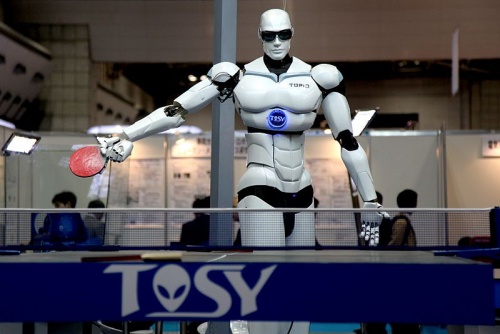The business of robotics
Today, robotics is no longer a hobby or a toy but a serious business. Robots are the 21st century cost-effective solutions to many problems. That is why in just a short time, there are hundreds of robotics companies selling robots in marketplace. According to the robotics industry, there is a huge need to integrate robotics into business to automate the process, make it faster, better and cost effective. Basically, the robotics market can be divided into three sectors: Industrial; Service; and Consumer.
The use of robots in industry is booming with more robots being developed each year. Last month, I saw a robot named KR-100 worked at a construction site. This robot can lift anything up to 1 ton and put it in a truck in just minutes. It also carries heavy equipments and materials from supply truck to construction sites in less than 20 minutes. The same job would require forty strong people to do in hours. A company representative told me that worldwide sales of industrial robots have reached $10 billion dollars in 2011. And those are just the hardware (Robots) but if you add software that control robots, the sale was over $20 billion. He said: “Out industry needs mechanical engineers and software engineers. We are hiring several thousand graduates each year to accommodate our fast growth but it is not enough. We need more but could not find them, especially software engineers with embedded software skills.”
Industrial robots are becoming a necessity in manufacturing sector because they can work nonstop 24 hours a day and 7 days a week. A robotic engineer told me that their robots are designed to last 10 to 15 years with less than 5 hours per month for maintenance such as changing oil and few small parts. He said: “You cannot find anyone who work 800 hours nonstop, always goes to work on time, and perform with high accuracy.” Currently there is growing demand for more robots in every industry because more companies are bringing manufacturing works back home rather than outsource to low cost countries. He concluded: “Basically outsourcing manufacturing trend is dead. I think Asian countries will be in big trouble when all manufacturing companies move back to the U.S. in the next few years. No human being can compete with robots and that is why robotics is a hot field today.”
Service robots are special types of robots that perform works in agriculture, medical, household and also military. This is a fast growing sector that is dominated by few very large companies. According to an industry representative, the market for these robots varies from $36 billion to $100 billion dollars depending on their applications. Military robots uses in battles are more expensive than household service robots that sweep floor, cook dinners and clean dishes. Healthcare robots are special robots that work in hospital and even perform some surgeries with high accuracy.
Robots for consumer markets are very popular with sales reaching $700 million dollars in 2011. There are thousand toy robots developed each year. Some are expensive but many are relatively cheap. Since the movie “The Transformers”, children are fascinated with robotic toys and this market is booming. Recently the trend is programmable robots where children can program robots to do many things, from running to dancing, from talking to singing. The most popular is Lego’s Mindstorms first designed for young children but has become very popular with adult too. There are many Lego’s robots with prices from one to several hundred dollars where children can build them, program them and even compete in robots tournaments.
Today the U.S. is still making robots look like a mechanical thing but the Japanese views robots differently. They want robots to look like real people. There are many Japanese robots that look like real people and perform jobs just like people. Last year when I went to a restaurant in Japan, I was greeted by a beautiful waitress who speaks English very well but she was a robot. My friend said: “Soon you will see robots in many places. They sell train tickets, cigarettes, candies, checking your baggage in train station. If you do not pay attention, you think they are real people.” I asked him: “What will happen to people who used to do those jobs?” He answered: “Most of them are re-trained to manage those robots. They watch them from special control rooms and monitor them via video camera to make sure that they do their job correctly. After all, robots cannot think and must follow people’s instructions.”
In few more years, we will see more robots perform all kinds of work instead of people. The robotics industry is booming and they need more graduates in science, technology, engineering, and math (STEM).
Sources
- Blogs of Prof. John Vu, Carnegie Mellon University
